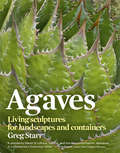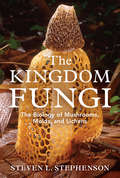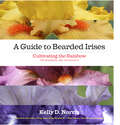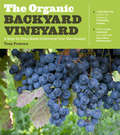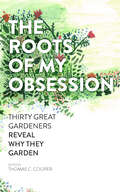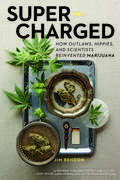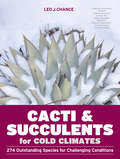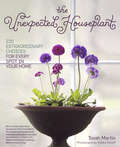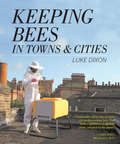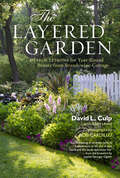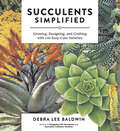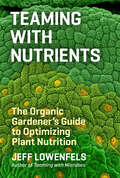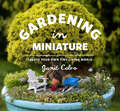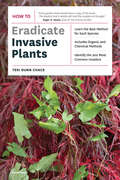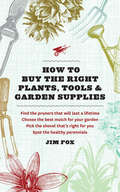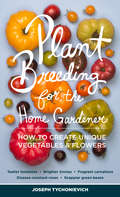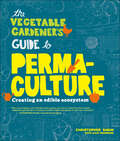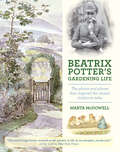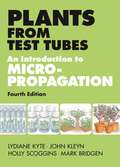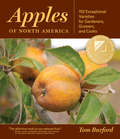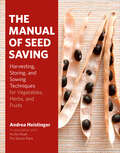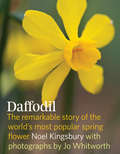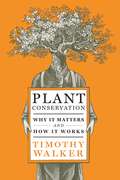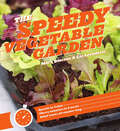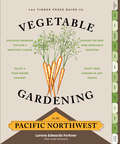- Table View
- List View
Agaves: Living Sculptures for Landscapes and Containers
by Greg StarrGardeners and garden designers are having a love affair with agaves. It's easy to see why—they're low maintenance, drought-tolerant, and strikingly sculptural, with an astounding range of form and color. Many species are strikingly variegated, and some have contrasting ornamental spines on the edges of their leaves. Fabulous for container gardening or in-the-ground culture, they combine versatility with easy growability. In Agaves, plant expert Greg Starr profiles 75 species, with additional cultivars and hybrids, best suited to gardens and landscapes. Each plant entry includes a detailed description of the plant, along with its cultural requirements, including hardiness, sun exposure, water needs, soil requirements, and methods of propagation. Agaves can change dramatically as they age and this comprehensive guide includes photos showing each species from youth to maturity—a valuable feature unique to this book.
The Kingdom Fungi: The Biology of Mushrooms, Molds, and Lichens
by Steven L. StephensonThe ubiquitous fungi are little known and vastly underappreciated. Yet, without them we wouldn’t have bread, alcohol, cheese, tofu, or the unique flavors of mushrooms, morels, and truffles. We can’t survive without fungi. The Kingdom Fungi provides a comprehensive look at the biology, structure, and morphological diversity of these necessary organisms. It sheds light on their ecologically important roles in nature, their fascinating relationships with people, plants, and animals, and their practical applications in the manufacture of food, beverages, and pharmaceuticals. The book includes information about “true” fungi, fungus-like creatures (slime molds and water molds), and a group of “composite” organisms (lichens) that are more than just fungi. Particular attention is given to examples of fungi that might be found in the home and encountered in nature. The Kingdom Fungi is a useful introductory text for naturalists, mycologists, and anyone who wants to become more familiar with, and more appreciative of, the fascinating world of fungi.
A Guide to Bearded Irises: Cultivating the Rainbow for Beginners and Enthusiasts
by Kelly NorrisThe diversity of bearded irises rivals that of any other perennial grown in temperate climates. For some gardeners, they bring back warm memories of a grandparent's garden; for others, they're a cutting-edge plant with a seemingly endless capacity for producing new forms and patterns.As the manager of Rainbow Iris Farm and co-editor of the Bulletin of the American Iris Society, Kelly Norris is the authority on gardening with bearded irises. His introductory chapters offer tips for successful growth, garden design, plant selection, and "creating" new irises. A Guide to Bearded Irises also provides portraits of the most outstanding plants in each of the six recognized categories, from the dainty miniature dwarf bearded irises to the stately tall bearded irises. A resource section lists specialty nurseries, organizations devoted to bearded irises, and public gardens with notable iris collections.
The Organic Backyard Vineyard: A Step-by-Step Guide to Growing Your Own Grapes
by Tom PowersInterest in wine shows no signs of slowing down—wine tours, tastings, and vacations are now common and homeowners often have space dedicated to their collection. The logical next step? Learning to grow and make your own.In The Organic Backyard Vineyard expert Tom Powers walks the small grower through the entire process of growing grapes, with a month-by-month maintenance guide covering all regions of the U.S. and Canada. He explains everything a beginning grape grower needs to know: how to design and build a vineyard, how to select grapes for each region, how to maximize yield using organic maintenance techniques, how to build a trellis, how to harvest at peak flavor, and how to store grapes for winemaking.This edition includes organic growing information and all new photography.
The Roots of My Obsession: Thirty Great Gardeners Reveal Why They Garden
by Thomas C. CooperWhy do you garden? For fun? Work? Food? The reasons to garden are as unique as the gardener.The Roots of My Obsession features thirty essays from the most vital voices in gardening, exploring the myriad motives and impulses that cause a person to become a gardener. For some, it’s the quest to achieve a personal vision of ultimate beauty; for others, it’s a mission to heal the earth, or to grow a perfect peach. The essays are as distinct as their authors, and yet each one is direct, engaging, and from the heart. For Doug Tallamy, a love of plants is rooted first in a love of animals: “animals with two legs (birds), four legs (box turtles, salamanders, and foxes), six legs (butterflies and beetles), eight legs (spiders), dozens of legs (centipedes), hundreds of legs (millipedes), and even animals with no legs (snakes and pollywogs).” For Rosalind Creasy, it’s “not the plant itself; it’s how you use it in the garden.” And for Sydney Eddison, the reason has changed throughout the years. Now, she “gardens for the moment.” As you read, you may find yourself nodding your head in agreement, or gasping in disbelief. What you’re sure to encounter is some of the best writing about the gardener’s soul ever to appear. For anyone who cherishes the miracle of bringing forth life from the soil, The Roots of My Obsession is essential inspiration.
Super-Charged: How Outlaws, Hippies, and Scientists Reinvented Marijuana
by Jim RendonMarijuana has been illegal in the United States since 1937. Yet, thanks in large part to a loosely connected underground world of breeders, dealers, and smokers, there are currently more than 2000 varieties available. And since 1996, when California first passed legislation allowing for legalized medical marijuana, the underground has slowly surfaced, pushing what was once a decentralized, lawless world closer to the corporate world of business, agriculture, and pharmaceuticals. Super-Charged gets up close and personal with the people who have transformed this controversial drug. With personalities and backgrounds as diverse as the plant itself, the growers include a former Silicon Valley software entrepreneur; third-generation Humboldt, California, growers; a publicly traded pharmaceutical company; and the famous marijuana personality Jorge Cervantes. Jim Rendon takes readers behind the scenes and into the homes and grow operations of the committed, quality-obsessed practitioners in the international underground industry responsible for creating today's super-charged cannabis. Ironically, these pioneers who built this illegal industry may one day find themselves out of business in the face of the drug's growing mainstream acceptance. Just how this could come about is part of the incredible story.
Cacti and Succulents for Cold Climates: 274 Outstanding Species for Challenging Conditions
by Leo J. ChanceThere are many reasons to grow cacti and other succulents—they're drought-tolerant, low-maintenance, and they look great. But what about hardiness? For those who thought that these spectacular plants were only for gardens in California and the Southwest, guess again—hundreds are fully cold-hardy and can be grown outdoors from New England to British Columbia, Wisconsin to Texas. Cacti and Succulents for Cold Climates is filled with inspirational portraits of 274 plants that can be used to create drought-tolerant gardens, as well as tips from regional experts who have mastered the art of growing cacti in parts of the country not usually associated with high temperatures or a scarcity of water. Expert Leo Chance describes how to prepare planting beds, how to get plants well established, how to handle cacti during planting, how to protect plants from cold winters, and when and how much to water.
The Unexpected Houseplant: 220 Extraordinary Choices for Every Spot in Your Home
by Tovah MartinIt's time for plant lovers to dust off their houseplants, update their image, and discover just how exciting, trendy, and crucial plants can be in the home.The Unexpected Houseplant, by renowned plant authority Tovah Martin, isn't your typical, old-fashioned, dowdy houseplant book. Martin's approach is revolutionary—picture brilliant spring bulbs by the bed, lush perennials brought in from the garden, quirky succulents in the kitchen, even flowering vines and small trees growing beside an easy chair. Martin brings an evangelist's zeal to the task of convincing homeowners that indoor plants aren't just a luxury—they're a necessity. In addition to design flair, houseplants clean indoor air, which can be up to ten times more polluted. Along with loads of visual inspiration, readers will learn how to make unusual selections, where to best position plants in the home, and valuable tips on watering, feeding, grooming, pruning, and troubleshooting, season by season.
Keeping Bees in Towns and Cities
by Luke DixonKeeping Bees in Towns and Cities features everything an urbanite needs to know to start keeping bees: how to select the perfect hive, how to buy bees, how to care for a colony, how to harvest honey, and what to do in the winter. Urban beekeeping has particular challenges and needs, and this book highlights the challenges and presents practices that are safe, legal, and neighbor-friendly. The text is rounded out with profiles of urban beekeepers from all over the world, including public hives at the Maryland Center for Horticulture, beekeeping on an office balcony in Melbourne, Australia, and a poolside hive at a hotel in Vancouver, British Columbia.
The Layered Garden: Design Lessons for Year-Round Beauty from Brandywine Cottage
by Rob Cardillo David L. Culp Adam Levine“Gardenmaking, in its finest form, is a celebration of life and of love. David and his book epitomize this.” —Lauren Springer Ogden Brandywine Cottage is David Culp's beloved two-acre Pennsylvania garden where he mastered the design technique of layering—interplanting many different species in the same area so that as one plant passes its peak, another takes over. The result is a nonstop parade of color that begins with a tapestry of heirloom daffodils and hellebores in spring and ends with a jewel-like blend of Asian wildflowers at the onset of winter.The Layered Garden shows you how to recreate Culp's majestic display. It starts with a basic lesson in layering—how to choose the correct plants by understanding how they grow and change throughout the seasons, how to design a layered garden, and how to maintain it. To illustrate how layering works, Culp takes you on a personal tour through each part of his celebrated garden: the woodland garden, the perennial border, the kitchen garden, the shrubbery, and the walled garden. The book culminates with a chapter dedicated to signature plants for all four seasons.
Succulents Simplified: Growing, Designing, and Crafting with 100 Easy-Care Varieties
by Debra Lee BaldwinSucculents are hot. And Debra Lee Baldwin, the bestselling author of Designing with Succulents and Succulent Container Gardens, is the ideal guide for gardeners, crafters, and DIYers looking for an introduction to these trendy, low-maintenance, drought-tolerant plants. Along with gorgeous photos packed with design ideas, Debra offers her top 100 plant picks and explains how to grow and care for succulents no matter where you live. Step-by-step projects, including a cake-stand centerpiece, special-occasion bouquets, a vertical garden, and a succulent topiary sphere, will inspire you to express your individual style. Whether you’re a novice or veteran, have an acre to fill or a few pots, live in Calexico or Canada, Succulents Simplified is a dazzling primer for success with succulents wherever you live!
Teaming with Nutrients: The Organic Gardener's Guide to Optimizing Plant Nutrition (Science For Gardeners Ser.)
by Jeff LowenfelsA 2014 Garden Writers Association Media Award Winner Just as he demystified the soil food web in his ground-breaking book Teaming with Microbes, in this new work Jeff Lowenfels explains the basics of plant nutrition from an organic gardener’s perspective. Most gardeners realize that plants need to be fed but know little or nothing about the nature of the nutrients and the mechanisms involved. In his trademark down-to-earth, style, Lowenfels explains the role of both macronutrients and micronutrients and shows gardeners how to provide these essentials through organic, easy-to-follow techniques. Along the way, Lowenfels gives the reader easy-to-grasp lessons in the biology, chemistry, and botany needed to understand how nutrients get into the plant and what they do once they’re inside.
Gardening in Miniature: Create Your Own Tiny Living World
by Janit CalvoGet ready to journey into the huge world of growing small!The next garden trend combines the joy of gardening with the magic of miniatures. Gardening in Miniature is a complete guide to creating lush, living, small-scale gardens. It has everything you need to pick up this new hobby, including scaled down garden designs, techniques for creating tiny hardscapes, miniature garden care and maintenance, tips on choosing containers, how to buy the right plants, and where to find life-like accessories. Inspiring step-by-step projects feature basic skills that can be recreated in any number of designs, like a tiny patio, a trellis, a pond, and a secret garden.Whether you want to build a miniature empire in your garden bed or design a private garden with a pebble patio for an indoor centerpiece, Gardening in Miniature is the primer for creating your own tiny, living world.
How to Eradicate Invasive Plants
by Teri Dunn Chace“Every garden shed should have a copy of this book. The wisdom that it wields will hold the invaders at the gate.” —Roger B. Swain, The Victory GardenHow to Eradicate Invasive Plants offers a clear, practical solution to the increasingly common problem of invasive plants. Clearly written and easy-to-use, Teri Dunn Chance shows you how to recognize more than 200 common invasive plants and offers organic and responsible chemical eradication options for each species. With this reference on their shelves, gardeners, landscapers, and managers of public and private land across the country can confidently tackle the invasive plants to make room for a sustainable plant community!
How to Buy the Right Plants, Tools, and Garden Supplies: Find The Pruners That Will Last A Lifetime Choose The Best Mulch For Your Garden Pick The Shovel That's Right For You Spot The Healthy Perennials
by Jim FoxAre you confused by all the choices when you visit a nursery? Do you get sticker shock when you see how much that nice little shade tree costs? Let Jim Fox, a nursery professional with over twenty years of experience, show you how to become a savvy garden consumer and get the most for your hard-earned landscaping dollars. <P><P>How to Buy the Right Plants, Tools, and Garden Supplies will arm you with a wealth of knowledge! You’ll learn how to determine if a plant is healthy, how to choose the right size, how to correctly read the plant tag, how to choose the best tools and supplies for your needs, and how to confidently recognize a well-made tool. <P><P> In addition to helping you navigate the nursery, it tells you what you need to know before you get there and offers helpful tips on how to successfully garden once you get home.With this essential guide in hand, you’ll never experience buyer’s remorse again!
Plant Breeding for the Home Gardener: How to Create Unique Vegetables and Flowers
by Joseph TychonievichBrighter zinnias, fragrant carnations, snappier green beansPlant Breeding for the Home Gardener makes it easier than ever to breed and grow your own varieties of vegetables and flowers. This comprehensive and accessible guide explains how to decide what to breed, provides simple explanations on how to cross plants, and features a basic primer on genetics and advanced techniques. Case studies provide breeding examples for favorite plants like daffodils, hollyhocks, roses, sweet corn, and tomatoes.
The Vegetable Gardener's Guide to Permaculture: Creating an Edible Ecosystem
by Julie Thompson Christopher Shein“A masterful distillation of permaculture in a way that is easy to apply to our gardens, farms, and lives today.” —David Cody, founder, Urban Permaculture Institute Once a fringe topic, permaculture is moving to the mainstream as gardeners who are ready to take their organic gardening to the next level are discovering the wisdom of a simple system that emphasizes the idea that by taking care of the earth, the earth takes care of you.The Vegetable Gardener's Guide to Permaculture teaches gardeners of every skill—with any size space—how to live in harmony with both nature and neighbors to produce and share an abundant food supply with minimal effort. Permaculture teacher Christopher Shein highlights everything you need to know to start living off the land lightly, including how to create rich, healthy, and low-cost soil, blend a functional food garden and decorative landscape, share the bounty with others, and much more.
Beatrix Potter's Gardening Life: The Plants and Places That Inspired the Classic Children's Tales
by Marta McDowell“An enchanting and original account of Beatrix Potter's life and her love of plants and gardening.” —Judy Taylor, vice president of the Beatrix Potter Society There aren’t many books more beloved than The Tale of Peter Rabbit and even fewer authors as iconic as Beatrix Potter. More than 150 million copies of her books have sold worldwide and interest in her work and life remains high. And her characters—Peter Rabbit, Jemima Puddle Duck, and all the rest—exist in a charmed world filled with flowers and gardens. Beatrix Potter’s Gardening Life is the first book to explore the origins of Beatrix Potter’s love of gardening and plants and show how this passion came to be reflected in her work. The book begins with a gardener’s biography, highlighting the key moments and places throughout her life that helped define her, including her home Hill Top Farm in England's Lake District. Next, the reader follows Beatrix Potter through a year in her garden, with a season-by-season overview of what is blooming that truly brings her gardens alive. The book culminates in a traveler’s guide, with information on how and where to visit Potter’s gardens today.
Plants from Test Tubes: An Introduction to Micropropogation, 4th Edition
by Holly Scoggins Mark BridgenThirty years ago, in vitro propagation was a new technique for producing plants, and Lydiane Kyte’s Plants from Test Tubes became the standard work on the topic.The new fourth edition has been thoroughly revised and updated to reflect the many advances in science and technology, including the five accepted sequential stages of micropropagation. Ten new plants have been added. This in turn has greatly expanded the already extensive bibliography. Among the new topics that have been introduced or expanded on are embryo culture for breeding, somaclonal variation, anther culture, somatic embryogenesis, cryopreservation, and genetic engineering. More ornamental plant examples are given and many new illustrations provided, including a chronology of discoveries in micropropagation.
Apples of North America: Exceptional Varieties for Gardeners, Growers, and Cooks
by Tom BurfordAmerican Horticulture Society Award Winner The apple is one of the most iconic fruits, traditionally picked on cool fall days and used in pies, crisps, and ciders. And there is a vast world of varieties that goes beyond the common grocery store offerings of Red Delicious and Granny Smith. With names like American Beauty, Carter’s Blue, and Fallawater, and flavors ranging from sweet to tart, this treasure trove of unique apples is ripe for discovery. There is no better guide through this tasty world than Tom Burford, whose family has grown apples in the Blue Ridge Mountains since 1715. The book is brimming with beautiful portraits of heirloom and modern apples of merit, each accompanied by distinguishing characteristics and common uses. As the view broadens to the orchard, you will find information on planting, pruning, grafting, and more. The exploration of the apple culminates with an overview of the fruit’s transformative capabilities when pressed, fermented, cooked, or dried. Beyond the polished and predictable grocery store display of Red Delicious and Granny Smith apples, a feast of beautiful and uniquely flavored North American varieties awaits the curious.
The Manual of Seed Saving: Harvesting, Storing, and Sowing Techniques for Vegetables, Herbs, and Fruits
by Ian Miller Andrea Heistinger“Makes it easy to find information in a snap, on most any edible you want to grow.” —Kylee Baumle, Horticulture Growing vegetables, fruits, and herbs from seed has many benefits for both the gardener and the planet. Why save seeds when you can buy them so cheap? Not only does seed saving allow you to grow a diverse, organic array of fruits and vegetables, it also offers an opportunity to work closely with nature and be even more hands-on with the food you grow, cook, and eat. Supported by research from the global conservation organizations Arche Noah and Pro Specie Rara, The Manual of Seed Saving features information on how to maximize seed quality and yield for crop plants like asparagus, carrots, corn, rhubarb, spinach, squash, and tomatoes. Plant profiles include critical information on pollination, isolation distances, cultivation, harvest, storage, and pests and diseases.
Daffodil: The remarkable story of the world's most popular spring flower
by Noel Kingsbury Jo WhitworthThere is no harbinger of spring like a field or garden filled with bright yellow daffodils. But the world of the daffodil is much more than just its place in the march of the seasons. It’s a plant whose history starts with the tombs of the Pharaohs, through pre-Darwin evolutionary theory and Cornwall’s burgeoning bulb business, and leads to the current explosion of varieties from plant breeders seeking new colors, fragrances, and forms.Daffodil reveals a global plant infatuation that has led to more than 25,000 cultivars available in nearly every shade of yellow (and now pink, orange, and white). Noel Kingsbury tells the tale through an engaging narrative history and plant portraits that highlight more than 200 varieties. Jo Whitworth's revealing photography shows a side of the daffodil rarely seen. Plant lovers will relish the stories and gardeners will cherish the cultivation notes, plant descriptions, and recommendations.
Plant Conservation: Why It Matters and How It Works
by Timothy WalkerPlants’ ability to turn sunlight into energy makes them the basis for all life; without them there is no life. And they are more than just a food source—they provide us with fuel, fibers, and pharmaceuticals. Global warming and the destruction of natural habitats are a serious threat to many plants, and there are worldwide efforts to mitigate the disaster. Plant Conservation tackles this essential topic head on. Timothy Walker, as the director of the Oxford Botanical Garden, a leader in the field of plant conservation, plays a key role in this effort. He highlights what is happening now, from cataloging the world’s flora to conservation efforts like protecting plants from overcollecting. He also shows home gardeners how they can become involved, whether by growing their own food to decrease reliance on large agriculture or by making smart plant choices by growing natives and avoiding invasives. Plant Conservation treats a critical topic in an accessible and optimistic way. It is required reading for students, professionals, and anyone with a keen interest in the importance of plants.
The Speedy Vegetable Garden
by Mark Diacono Lia LeendertzTypically, vegetable gardening is about the long view: peas sown in spring aren't harvested until summer, and tomatoes started indoors in February can't be eaten until July. But it's not true for all plants. Some things can be planted and eaten in weeks, days, even hours.The Speedy Vegetable Garden highlights more than 50 quick crops, with complete information on how to sow, grow, and harvest each plant, and sumptuous photography that provides inspiration and a visual guide for when to harvest. In addition to instructions for growing, it also provides recipes that highlight each crop’s unique flavor, like Chickpea sprout hummus, stuffed tempura zucchini flowers, and a paella featuring calendula. Sprouted seeds are the fastest. Microgreens can be harvested in weeks: cilantro, 14 days after planting; arugula and fennel in 10 days. And a handful of vegetable varieties grow more quickly than their slower relatives, like dwarf French beans (60 days), cherry tomatoes (65 days), and early potatoes (75 days).The Speedy Vegetable Garden puts fresh, seed-to-table food at your fingertips, fast!
The Timber Press Guide to Vegetable Gardening in the Pacific Northwest: A Timber Press Guide (Regional Vegetable Gardening Series)
by Lorene Edwards ForknerThere is nothing more regionally specific than vegetable gardening. What to plant, when to plant it, and when to harvest are unique decisions based on climate, weather, and first and last frost.The Timber Press Guide to Vegetable Gardening: Pacific Northwest is a growing guide that truly understands the unique eccentricities of the Northwest growing calendar, covering Oregon, Washington, southeastern Alaska, and British Columbia. The month-by-month format makes it perfect for beginners and accessible to everyone—you can start gardening the month you pick it up. Starting in January? The guide will show you how to make a seed order, plan crop rotations and succession plantings, and plant a crop of microgreens. No time to start until July? You can start planting beets, carrots, chard, kale, parsnips, and spinach for an early fall harvest.
